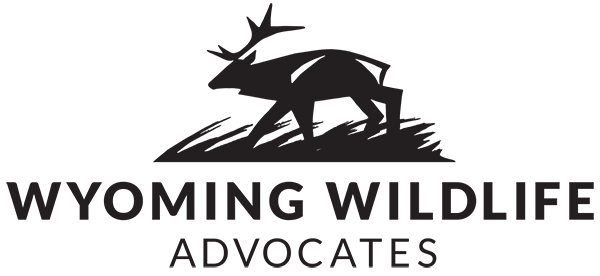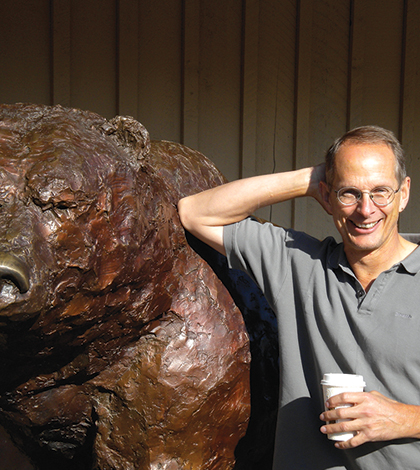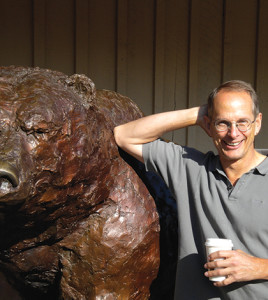by Jake Nichols/Planet Jackson Hole | JULY 7, 2015
The grizzly bear population in the United States is …Fill in the blank.
Wildlife biologists say everything from rebounding to robust. Conservationists and wildlife advocates might answer: encouraging, but still threatened. Ranchers and some subdivision homeowners on the perimeter of urban-wildland interfaces might call the grizzly a nuisance at best. But it’s what politicians in Washington are prepared to say about griz numbers that will hold sway in the forests of the northern Rockies where ursus arctos horribilis has made its last stand against extirpation in the Lower 48.
Coming to America
By the time Lewis and Clark encountered the Mandan’s fabled “white bear” on April 29, 1805, the grizzly had been entrenched in the West, possibly numbering in the hundreds of thousands. Unlike the black bear known in the eastern U.S., the silver-tipped grizzly was a formidable foe.
“The black bear mostly evolved in North America,” renowned bear expert David Mattson said. “It grew up in heavily forested areas where its main defense was climbing a tree. The grizzly emerged from the steppe-tundra of Eurasia where the wide-open nature of the land is probably why the grizzly is more aggressive and stands its ground. Its claws, for instance, grew and developed more for ripping things open than for climbing.”
Scientists are fairly certain the griz migrated here by walking over the Beringia land bridge connecting Siberia and North America. Their assumptions that the migration took place during the last ice age, approximately 7,000 to 13,000 years ago, were turned upside down with a recent discovery made near Edmonton, Alberta, Canada. Grizzly remains found there were carbon dated to roughly 32,000 years ago, meaning the bear likely made the journey over the Crodilleran and Laurentide ice sheets between 55,000 and 70,000 years ago.
When melting glaciers slammed the door shut behind them, grizzlies were left to contend with larger, now-extinct carnivores from another era. Then came Native Americans, then European settlers.
Today, we are left with pockets of survivors. The Kluane and Yukon grizzlies known as Kodiak or brown bears took refuge in the harsh Canadian terrain. Some went to the coast to feast on salmon. Their southern cousins clung to isolated pockets of the Rocky Mountain West including portions of Wyoming, Idaho and Montana. Biologists still debate the differences between the species – some classifying the different bruins as subspecies or clades. But Mattson said one thing is for sure: the Yellowstone grizzly is a bear all to itself. It mostly has to do with its diet.
Grizzly habitat forecast: Grisly
“The first point to be made about the diet of Yellowstone grizzly is it is altogether unique for any grizzly in the world,” Mattson said. “In the past, say the mid-70s to early-2000s, grizzlies got a vast majority of their protein from white bark pine, elk and cutthroat trout. Moths came into their diet in the mid-80s. But since the early-2000s, virtually all cone-producing white bark pine have been eliminated by beetle. Cutthroat trout have been decimated by changing stream flows, rising temperatures and illegally-introduced lake trout.”
With two of the bear’s four favorite food sources nearly wiped out, the omnivore has been turning into more of a meat eater. Elk and moose now provide grizzlies with much-needed protein but at a price.
Bears don’t distinguish between wild meat on the hoof or domestic cattle and sheep. It’s all fair game to them. Run-ins with ranchers and hunters have become more frequent. “This turn to meat is not cost free, in fact it is a hazardous undertaking for the bears,” Mattson explained.
Combine this taste for blood with the grizzly bear’s legendary sense of smell and large swath through the forest – females range 300 square miles of territory on average; males, twice that – and the potential for conflict is inevitable.
Mattson has worked with ranchers on ways they can coexist with the grizzly. Early results from the Blackfoot Challenge – a study of balancing the needs of people and wildlife in Montana’s Blackfoot Watershed – have been encouraging.
“Conflicts there have dropped to essentially nil,” Mattson said. “We can live with bears even if we’ve got livestock. It’s a proven fact.”
With the estimated population closing in on 1,000 grizzlies in the U.S., some say Yellowstone has reached its carrying capacity and the bear should be delisted. Roughly 500 bears are necessary to avoid inbreeding, Mattson said, but maybe 5,000 are needed to ensure a healthy genetic diversity. And don’t get him started on the so-called “magic 1,000” plateau.
“The thousand bear estimate has been bandied about lately,” Mattson said. “I’m kind of mystified when people say we’ve got 1,000 bears as if that was a lot. That’s about the population of people in Dubois. Put that number into context. We’ve got 400,000 cows in the counties that are in the grizzly’s ecosystem, and at least that many people.
“How would you feel if the future of the entire human race was dependent on the residents of Dubois, totally cut off and isolated from the rest of humanity, to procreate and thrive? Most people would not feel very secure with that situation.”
A buffer of 1,000 bears is not enough, Mattson said, especially if hunting the griz is introduced. Also, the isolation of Yellowstone’s grizzly population makes the bears more susceptible to genetic mutation and environmental hardships. Finding the right balance between healthy bear numbers and peaceful coexistence with a quarter ton of beast capable of shredding a Buick to get to lunch in the trunk is tricky and, according to Mattson, is less about charts and graphs, and more about the human condition.
“How much room there is for bears has a lot more to do with what’s going on between people’s ears more than the physical realities of things like carrying capacity of the land,” Mattson said. “Encroachment is a matter of perception.”
The grizzly population has remained stagnant or even in decline since 2008, Mattson said. Increased sightings or conflict create an “inflated perception of how many bears are out there.”
“We have grizzly spread out over 40 percent more area since 2002,” he said. “So these sightings are mainly on the periphery where there are more people.”
Bearly believable
There is so much about the grizzly bear we have yet to learn. Wildlife biologists like Mattson have mounds of data to sift through but extrapolations and assumptions fill in the gaps as far as diet, genetic makeup and migration to America. And forget about hibernation. It’s one of the most puzzling mysteries in all the animal kingdom.
“When it comes to hibernation itself, it’s mind-boggling to me,” Mattson said. “Curling up for four to six months without taking food or water, without defecating or urinating, and then emerging in the spring with as much muscle mass and bone density as when you entered the den? And without having experienced massive kidney failure? It’s nothing short of miraculous.”
Scientists have studied the unique capabilities of hibernating bears for possible applications to the medical field and space travel. A denning bear enters a near suspended animation state. Heart rate slows from 50-beats-per-minute to eight. The bear’s body core temps remain very near normal, however, unlike hibernating squirrels and marmots. Those critters’ body temperatures plummet to below 40 degrees Fahrenheit, which is why they must awaken every few days.
Bears feed off themselves during winter hibernation. Fat tissues supply water, keeping the bear perfectly hydrated. Muscle and organ tissues furnish the slumbering bruin with a 4,000-calorie-per-day protein diet yet, despite the inactivity, bears don’t have high cholesterol problems. They emit natural bile to fight hardening of the arteries and dissolve gallstones. Not only do bears not waste away during the months of hibernation, they effectively use their own urine to restore muscles and organs.
“There’s been lots of research in the last 15 years but the mystery is still unsolved,” Mattson said. “We still have not unlocked those fundamental mechanisms behind hibernation.”
There is anecdotal evidence in the Greater Yellowstone Ecosystem that grizzlies are hibernating for shorter periods of time. They den late and wake early.
“Bears are not denning as long,” Mattson said. “It probably has something to do with climate change. Also, eating more meat, compared to vegetal foods, means they can get food sources later in the years and early in the spring.”
Dr. Mattson is the featured guest speaker at an event hosted by Wyoming Wildlife Advocates, the Sierra Club and others at the National Museum of Wildlife Art on July 15.


